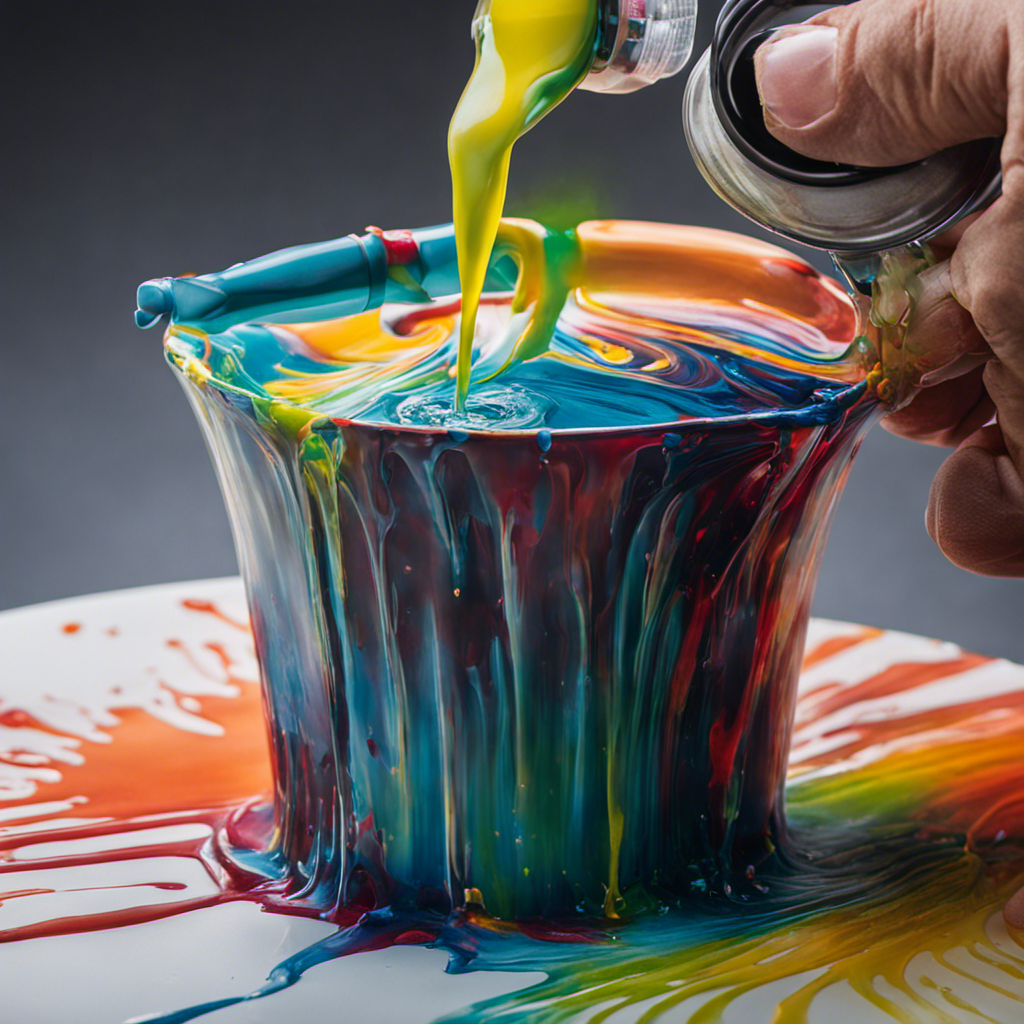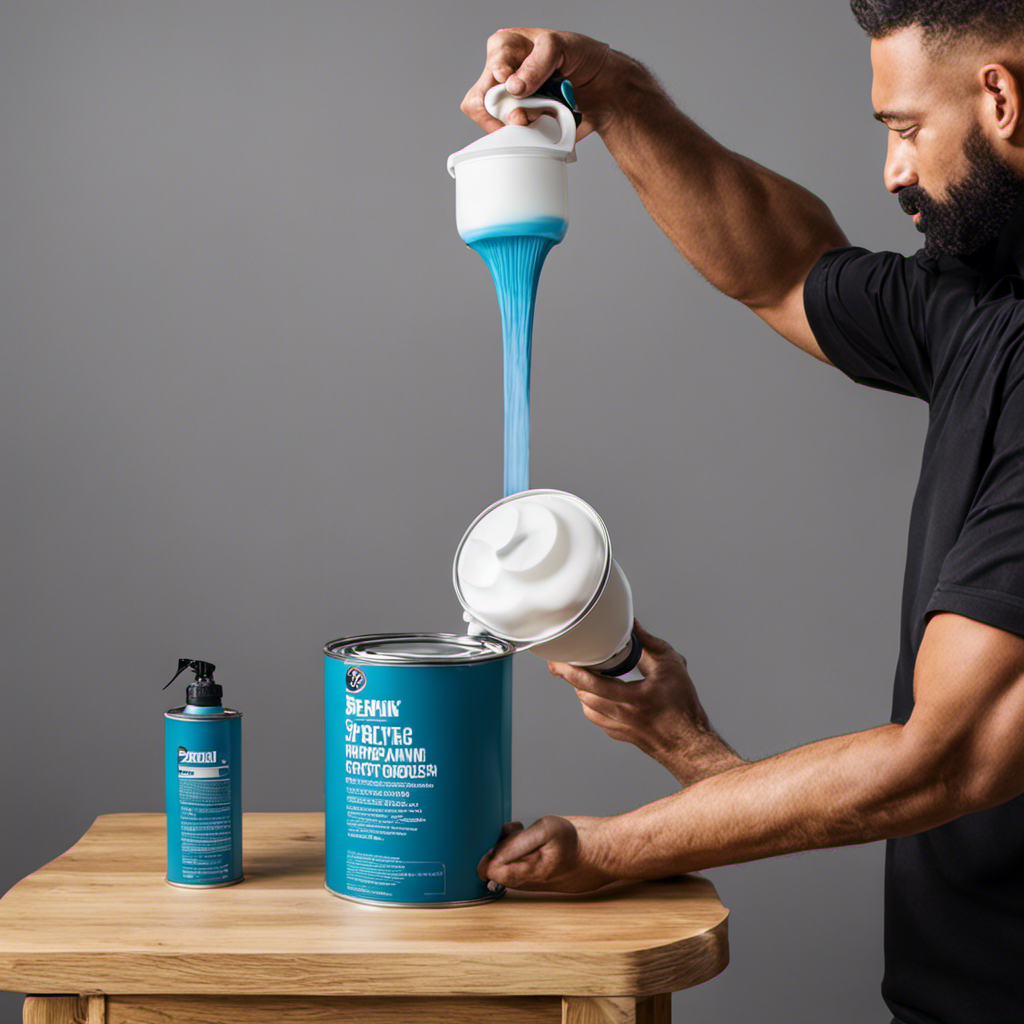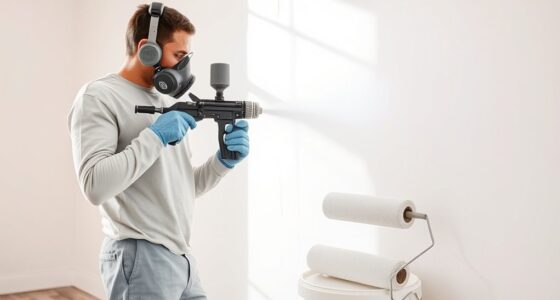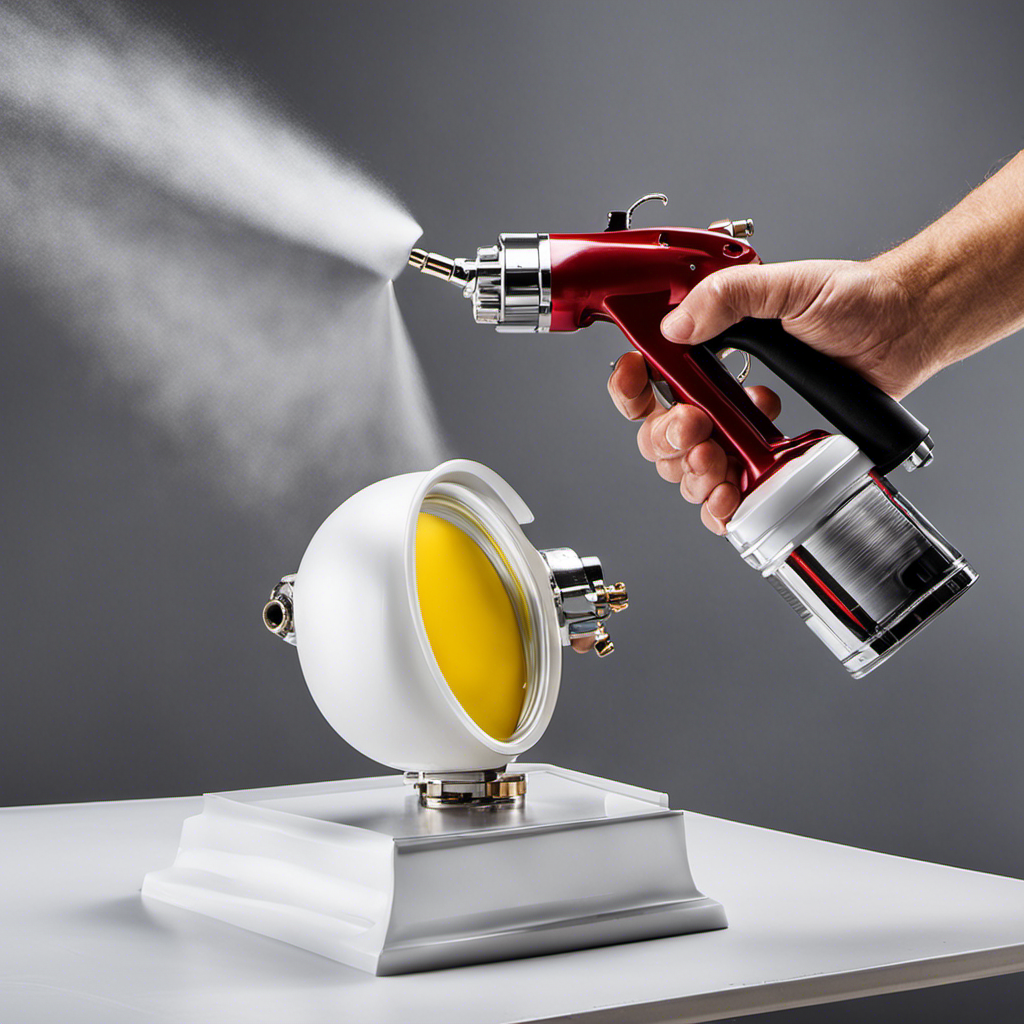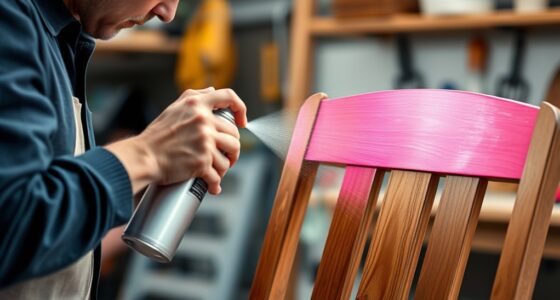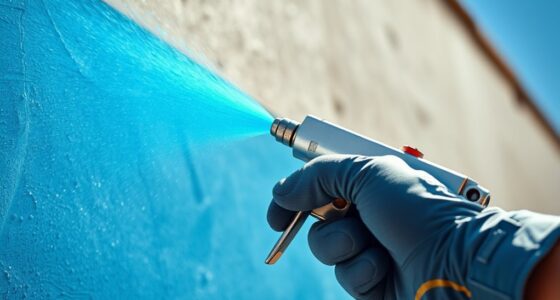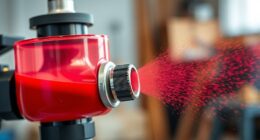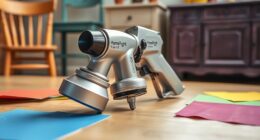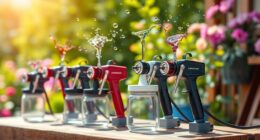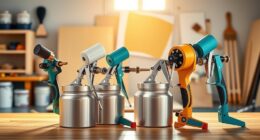In order to achieve consistent coverage and smooth application, it is important to dilute acrylic paint. This step enhances the flow of the paint and distribution, preventing clogs and promoting better adhesion to the desired surface.
Water or acrylic paint thinner can be used for this purpose, with commercial acrylic paint thinners offering more control. It’s crucial to have the right supplies and choose the appropriate paint sprayer.
By adding small amounts of water or acrylic paint thinner and testing the consistency, the desired results can be achieved. Proper cleaning and storage techniques are also essential for the longevity of your sprayer.
Key Takeaways
- Thinning acrylic paint improves the spray pattern and flow of the paint for an airless paint sprayer.
- Thinning the paint results in a smoother and more even application.
- Thinning prevents clogging and ensures proper adhesion to the surface.
- Water or acrylic paint thinner can be used to thin acrylic paint.
Importance of Thin Paint for Spray Applications
Thinning acrylic paint is important for spray applications as it improves the spray pattern and flow of the paint. When acrylic paint is too thick, it can result in an uneven application and clog the sprayer. By thinning the paint, it becomes smoother and easier to work with, ensuring a more even and professional finish.
Thinning also helps the paint adhere properly to different surfaces, preventing peeling or flaking. However, there are common mistakes to avoid when thinning acrylic paint. One mistake is adding too much water or acrylic medium, which can make the paint too thin and cause it to run or drip. Another mistake is not testing the consistency of the thinned paint before spraying, leading to issues with coverage and adhesion.
It is important to follow proper techniques and guidelines to achieve the desired results when thinning acrylic paint for spray applications.
Benefits of Thinning Acrylic Paint for Airless Sprayers
Improving the flow and spray pattern, thinning acrylic paint allows for more efficient use with airless sprayers. Thinning the paint not only enhances the application but also provides several benefits for spray applications.
By reducing the viscosity of the paint, it becomes easier to atomize and achieve a smoother, more even coat. Thinning acrylic paint also helps prevent clogging in the sprayer, ensuring uninterrupted spraying.
However, there are common mistakes that one should avoid when thinning acrylic paint for spray applications. Over-thinning the paint can result in poor coverage and adhesion, while under-thinning can lead to clogs and an uneven spray pattern.
It is important to carefully follow the manufacturer’s instructions and test the thinned paint on a scrap surface before proceeding with the actual project.
Using Water and Acrylic Medium to Thin Acrylic Paint
To achieve the desired consistency, the artist can add small amounts of water or acrylic medium when preparing the acrylic paint. Thinning acrylic paint is essential for achieving a smooth finish and ensuring optimal performance with paint sprayers.
Here are some techniques for thinning acrylic paint:
-
Water: Water is commonly used for minor thinning. Add small amounts of water to the paint and mix thoroughly until the desired consistency is achieved.
-
Acrylic Medium: Acrylic medium is ideal for significant thinning. Gradually add small amounts of medium to the paint, mixing thoroughly after each addition.
-
Combination of Water and Acrylic Medium: For more control over the thinning process, you can use a combination of water and acrylic medium. Experiment with different ratios to find the perfect consistency.
-
Testing: Always test the thinned paint on a scrap surface to ensure the desired consistency and coverage before applying it with a sprayer.
Choosing the Right Supplies for Thinning Acrylic Paint
Choosing the appropriate supplies is crucial for achieving the desired consistency when thinning acrylic paint. When it comes to choosing the right thinning agents, there are a few options to consider.
Water is commonly used for minor thinning, while acrylic medium is used for significant thinning. Commercial acrylic paint thinners can also provide more control over the thinning process.
Comparing different thinning techniques can help determine the best approach for achieving the desired results. Some artists prefer to use water for a more subtle thinning effect, while others opt for acrylic medium for a more significant reduction in viscosity.
It’s important to experiment with different techniques to find the one that works best for you. By carefully selecting the appropriate supplies and comparing different thinning techniques, artists can achieve the desired consistency when thinning acrylic paint.
Understanding Different Techniques for Thinning Paint
Understanding different techniques for thinning paint allows artists to customize the consistency of their acrylic paint for optimal application. Thinning acrylic paint can be done in various ways, each with its own advantages and disadvantages.
-
Water: Using water to thin acrylic paint is a common method that is easily accessible and cost-effective. It is suitable for minor thinning and provides good flow and coverage. However, excessive use of water can weaken the paint’s adhesion and reduce its vibrancy.
-
Acrylic Medium: Acrylic medium is specifically designed to thin acrylic paint and offers more control over the thinning process. It allows for significant thinning without compromising the paint’s integrity. However, acrylic medium can be more expensive compared to water.
-
Commercial Acrylic Paint Thinners: These thinners are formulated specifically for acrylic paint and offer precise control over the thinning process. They can be used in combination with water or acrylic medium to achieve the desired consistency. However, they can be more expensive and may have strong fumes that require proper ventilation.
-
Combination: Some artists prefer to use a combination of water and acrylic medium or commercial thinners to achieve a balance between cost-effectiveness and control over the thinning process.
Determining the Ideal Consistency for Smooth Application
Achieving the ideal consistency ensures that the artist can apply the acrylic paint smoothly and evenly. Determining the optimal consistency is crucial for a successful painting process.
To achieve this, the artist should pour a small amount of paint into a container and evaluate its thickness. If the paint is too thick, it may clog the sprayer, while if it is too thin, it may not adhere properly.
Troubleshooting thinning issues is necessary to achieve the desired consistency. The artist can adjust the consistency by adding small amounts of water or acrylic paint thinner. It is important to make gradual adjustments and test the paint on a scrap surface to ensure the desired consistency and coverage.
Adjusting the Thickness of Acrylic Paint for Spraying
To adjust the thickness of acrylic paint for spraying, the artist can gradually add water or acrylic medium to achieve the desired consistency. This allows for better control over the paint flow and ensures a smooth and even application. By adjusting the consistency, the artist can prevent clogging in the sprayer and ensure proper adhesion to the surface.
To assist in understanding this process, here are four important points to consider:
- Gradually add water or acrylic medium to thin the paint.
- Mix the solution thoroughly to achieve a smooth texture.
- Test the thinned paint on a scrap surface to ensure the desired consistency and coverage.
- Clean the sprayer properly after use to maintain its longevity.
Troubleshooting Thinning Issues for Acrylic Paint
The artist can troubleshoot thinning issues by evaluating the consistency of the paint and adjusting accordingly with small amounts of water or acrylic medium.
Achieving optimal consistency is crucial for a smooth and even application of acrylic paint. If the paint is too thick, it may clog the sprayer, while if it is too thin, it may not adhere properly.
To troubleshoot thinning issues, the artist should pour a small amount of paint into a container and evaluate its thickness. They can then add small amounts of water or acrylic paint thinner to adjust the consistency. Gradually mixing the thinned paint and testing it on a scrap surface will ensure the desired consistency and coverage.
Mixing and Testing Thinned Acrylic Paint for Spray
When mixing and testing thinned acrylic paint for spray, the artist should gradually add water or medium and thoroughly mix the solution to ensure a smooth texture. Evaluating consistency and testing coverage are crucial steps in achieving the desired results.
Here are some tips to help with this process:
- Pour a small amount of thinned paint into a container and evaluate its thickness.
- Adjust the consistency by adding small amounts of water or acrylic paint thinner as needed.
- Use a stirring stick or paint mixer attachment to thoroughly mix the paint.
- Test the paint on a scrap surface to evaluate its consistency and coverage.
Proper Loading and Spraying Techniques for Thinned Paint
Proper loading and spraying techniques for thinned paint ensure an even and consistent application. Achieving even coverage is crucial for a professional finish.
When loading the paint into the sprayer, make sure the container is securely attached and all connections are checked. Start spraying with a smooth and continuous motion, holding the sprayer at a consistent distance from the surface. Keep the sprayer level and avoid stopping or starting abruptly to prevent uneven application.
Maintain a steady pace and overlap each pass slightly to ensure complete coverage. It is important to troubleshoot any issues that may arise, such as inconsistent spray or drips, to maintain an even application.
Following these proper spraying techniques will result in a smooth and flawless finish.
Cleaning Up After Using Thinned Acrylic Paint
After using thinned acrylic paint, it is important to clean the sprayer properly to ensure its maintenance. Here are some tips to follow:
- Clean the sprayer thoroughly using warm water and mild detergent.
- Pay attention to the nozzle and other parts that may have paint residue.
- Rinse the sprayer with clean water to remove any soap residue.
- Dry the sprayer completely before storing to prevent rust or damage.
Proper cleaning not only ensures the sprayer’s functionality but also prevents clogging and extends its lifespan. When storing the sprayer, keep it in a dry and secure location. Protect it from dust and debris by using a cover or storage case.
Maintaining and Storing Your Airless Paint Sprayer
To ensure the longevity of their airless paint sprayer, the user should store it in a dry and secure location, protecting it from dust and debris with a cover or storage case. This is essential for maintaining sprayer durability and preventing paint clogs. Proper storage not only protects the sprayer from external elements but also ensures that internal components remain clean and in good working condition. Additionally, regular maintenance and cleaning are crucial for extending the lifespan of the sprayer. This includes flushing out any remaining paint, checking and replacing worn or damaged parts, and lubricating moving components. By following these meticulous steps, users can maximize the durability of their airless paint sprayer and ensure optimal performance for years to come.
| Tips for Maintaining and Storing an Airless Paint Sprayer |
|---|
| 1. Store in a dry and secure location |
| 2. Use a cover or storage case to protect from dust and debris |
| 3. Perform regular maintenance and cleaning |
Tips for Cleaning and Longevity of Your Sprayer
Regular maintenance and cleaning of the airless paint sprayer is essential for extending its lifespan and ensuring optimal performance for years to come. To keep your sprayer in top shape, here are some cleaning techniques and sprayer maintenance tips to follow:
- Flush the sprayer with clean water after each use to remove any leftover paint.
- Use a soft brush or cloth to clean the nozzle, filter, and other components thoroughly.
- Check for any clogs or blockages and clear them using a cleaning solution or a nozzle cleaning tool.
- Lubricate the moving parts of the sprayer regularly to prevent rust and ensure smooth operation.
Protecting Your Sprayer From Dust and Debris
Cleaning the airless paint sprayer regularly and storing it in a dry and secure location helps protect it from dust and debris. By taking these precautions, you can ensure the longevity of your sprayer and prevent clogs and damage. Dust and debris can accumulate inside the sprayer, leading to clogs in the nozzle and other parts. This can affect the performance and efficiency of the sprayer, resulting in uneven spray patterns and wasted paint. To protect your sprayer, it is recommended to clean it after each use, removing any paint residue and debris. Storing the sprayer in a dry and secure location, such as a storage case or cabinet, will further prevent dust and debris from settling on the equipment. By following these steps, you can maintain the quality and functionality of your sprayer for years to come.
| Tips for Protecting Your Sprayer |
|---|
| 1. Clean the sprayer after each use |
| 2. Remove any paint residue and debris |
| 3. Store the sprayer in a dry and secure location |
| 4. Use a cover or storage case to protect from dust and debris |
Best Practices for Storing Thinned Acrylic Paint and Sprayer
After ensuring the sprayer is clean and free of debris, it’s important to store both the thinned acrylic paint and the sprayer properly to prevent paint contamination and maintain their longevity. Here are some best practices for storage:
- Clean the sprayer thoroughly before storage to remove any residual paint.
- Store the sprayer in a dry and secure location to prevent moisture damage.
- Protect the sprayer from dust and debris by covering it with a storage case or using a dust cover.
Store the thinned acrylic paint in airtight containers to prevent evaporation and maintain its consistency.
Frequently Asked Questions
Can I Use Regular Water to Thin Acrylic Paint for Spraying?
Yes, regular water can be used to thin acrylic paint for spraying. It is a common and cost-effective method to achieve the desired consistency.
However, it is important to note that using additives such as acrylic medium or commercial paint thinners can provide more control over the thinning process. These alternative thinning methods offer different effects and may be preferred depending on the specific project requirements.
Experimentation and testing are recommended to determine the best thinning method for optimal results.
What Is the Ideal Consistency of Thinned Acrylic Paint for Smooth Application?
The ideal consistency of thinned acrylic paint for smooth application is comparable to pouring cream or a runny pancake batter. It should flow easily from the container, without being too thick or watery.
When sprayed, the paint should create a fine mist that evenly coats the surface. Achieving this consistency requires gradually adding small amounts of water or acrylic medium and thoroughly mixing the solution.
Testing the thinned paint on a scrap surface helps ensure the desired coverage and consistency before loading it into the sprayer.
How Do I Troubleshoot Issues With Thinning Acrylic Paint for Spraying?
To troubleshoot issues with thinning acrylic paint for spraying, one should first ensure that the paint has been thinned to the optimal consistency for achieving even coverage. If the paint is too thick, it may clog the sprayer, while if it is too thin, it may not adhere properly.
To adjust the consistency, small amounts of water or acrylic paint thinner can be added. Testing the thinned paint on a scrap surface can help ensure the desired consistency before loading and spraying.
Can I Use Acrylic Medium Alone to Thin Acrylic Paint for Spraying?
Using acrylic medium alone to thin acrylic paint for spraying may not be the most effective option. While acrylic medium can be used for significant thinning, it is typically used in combination with water for better results.
Alternatives to acrylic medium for thinning paint include using water alone or a commercial acrylic paint thinner. It is important to experiment with different ratios of acrylic medium and water to achieve the desired consistency for a smooth and even spray.
What Are the Best Practices for Storing Thinned Acrylic Paint and the Sprayer?
Storage tips for thinned acrylic paint and the sprayer include proper cleaning and careful storage.
After using the sprayer, disconnect it from the power source and clean it thoroughly with warm water and mild detergent. Once clean, store the sprayer in a dry and secure location, protecting it from dust and debris with a cover or storage case.
As for the thinned acrylic paint, store it in airtight containers to prevent drying out. Label the containers with the color and date to keep track of the paint’s freshness.
Conclusion
In conclusion, thinning acrylic paint is a crucial step in achieving a flawless spray application. By using water or acrylic paint thinner, painters can improve flow, prevent clogging, and ensure proper adhesion.
The right supplies and techniques are essential for achieving the desired consistency and coverage. Additionally, proper cleaning and storage of the airless paint sprayer are necessary for longevity.
By following these best practices, painters can protect their sprayer, maintain the quality of thinned acrylic paint, and produce remarkable results.
Stay tuned for more expert tips and techniques to enhance your painting experience.
Franz came aboard the Paint Sprayer Zone team with a background in both journalism and home renovation. His articulate writing style, combined with a passion for DIY projects, makes him an invaluable asset. Franz has a knack for breaking down technical jargon into easy-to-understand content, ensuring that even the most novice of readers can grasp the complexities of paint sprayers.
